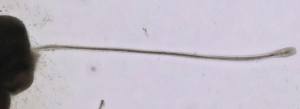A team of researchers from Japan studying the processes of hair follicle growth and hair pigmentation has successfully generated hair follicles in cultures, by controlling epithelial-mesenchymal interactions (EMI), and the arrangement of epithelial and mesenchymal cells in three dimensions, in vitro. The scientists, headed by Tatsuto Kageyama, PhD, an assistant professor with the faculty of engineering at Yokohama National University, suggest that the hair follicle model will provide new insights into hair follicle development, which could point to the development of new approaches for treating hair loss disorders, and also potentially have relevance for animal testing and drug screening.
Reporting their work in Science Advances, in a paper titled, “Reprogramming of three-dimensional microenvironments for in vitro hair follicle induction,” Kageyama and colleagues concluded, “This approach may be useful not only for understanding of the basis of EMIs in hair follicle induction but also for applications as alternatives to animal testing, hair follicle regeneration, and drug screenings.”
As an embryo develops, interactions occur between the outer layer of skin called the epidermal layer, and the connective tissue called mesenchyme. These epithelial-mesenchymal interactions work kind of like a messenger system to trigger the development of various tissues and organs, including hair follicle morphogenesis. Morphogenesis is the process in an organism where cells are organized into tissues and organs.
Over recent decades scientists have used animal models to investigate critical mechanisms involved in hair follicle development. But fully understanding the processes involved in hair follicle development remains challenging, and to date hair follicle morphogenesis has not been successfully reproduced in a laboratory culture dish. “Although knockout and knockdown mouse models can be used to identify key genes and signals related to hair follicle development based on the appearance of body hairs, fully elucidating molecular mechanisms for EMIs remains challenging because of the crowded in vivo environment,” the team explained.
The use of organoid cultures in research has more recently been the focus of widespread attention. As tiny, simple versions of an organ, scientists produce and use organoids to study tissue and organ development and pathology in a laboratory culture dish. “Organoids were a promising tool to elucidate the mechanisms in hair follicle morphogenesis in vitro,” said Kageyama.
Some progress had previously been reported with the reconstruction of hair follicle germ (HFG)-like aggregates in culture, using dissociated embryonic epithelial and mesenchymal cells, the team continued. “When transplanted into the skin of nude mice, HFGs generated de novo hair follicles, implicating that HFGs have hair neogenesis capability.” However, the investigators pointed out, inducing the generation of matured hair follicles and hair neogenesis in cultures has remained challenging.
For their reported study investigators fabricated hair follicle organoids by controlling the structure generated by epithelial and mesenchymal embryonic cells, using quite a low concentration of extracellular matrices. The extracellular matrices adjusted the spacing between the two types of embryonic cells from a dumbbell shape to a core-shell configuration. Newly formed hair follicles with typical features emerged in core-shell-shape groups. These core-shell-shape groups increase the contact area between two cell regions to enhance the mechanisms that contribute to hair follicle growth.

The team, in addition, examined the feasibility of using hair follicle organoids for drug screening and regenerative medicine. They also added into the culture medium a melanocyte-stimulating drug which plays a key role in producing hair color pigmentation. With the addition of this drug, the researchers significantly improved the pigmentation of the hair-like fibers. Furthermore, by transplanting the hair follicle organoids, they achieved efficient hair follicle regeneration with repeating hair cycles.
The scientists believe that this in vitro hair follicle model could help scientists gain a better understanding of hair follicle induction, evaluate hair pigmentation and hair growth drugs, and potentially how to regenerate hair follicles.
The method is also scalable, they noted, opening up the potential for additional avenues of research. “The large-scale preparation of hair follicloids can be combined with genetic engineering technology (using CRISPR-Cas9, short interfering RNA, and signal inhibitor) to perform a comprehensive analysis of key genes related to hair follicle development, hair pigmentation, and hair follicle diseases.”
The findings could also prove to be relevant to other organ systems, and contribute to the understanding of how physiological and pathological processes develop. “Because EMIs are crucial for the morphogenesis of other tissues and organs, this may provide a versatile approach for the preparation of other organoids,” the scientists suggested.
The reported research used mouse cells, but looking ahead to future research, the team plans to optimize their organoid culture system using human cells. “Our next step is to use cells from human origin, and apply for drug development and regenerative medicine,” said co-author Junji Fukuda, PhD, a professor with the faculty of engineering at Yokohama National University. In their paper, the authors noted, “…we are currently investigating our approach using cells from human tissue stem cells from hair follicle donors or cells induced from human pluripotent stem cells.”
Future research could eventually point to new therapeutic strategies for hair loss disorders such as androgenic alopecia, which is common in both men and women. “This in vitro hair follicle model might be valuable for better understanding hair follicle induction, evaluating hair growth and inhibition of hair growth by drugs, and modeling gray hairs in a well-defined environment,” the investigators suggested.

